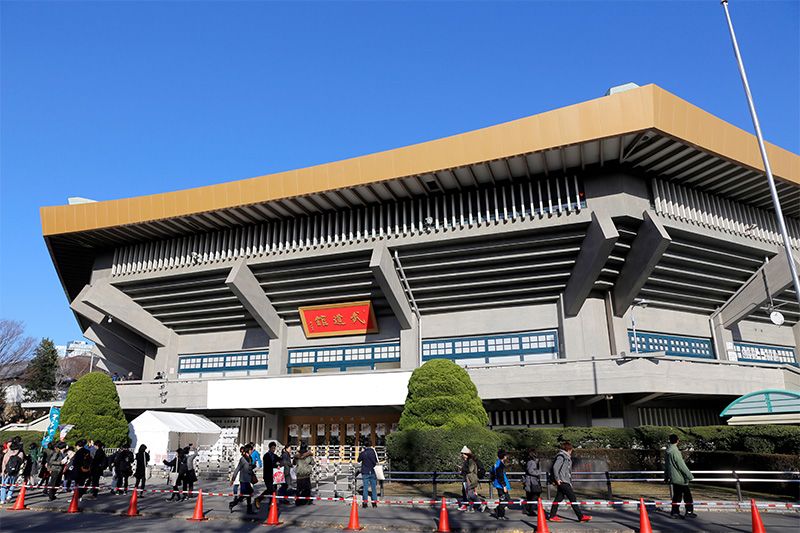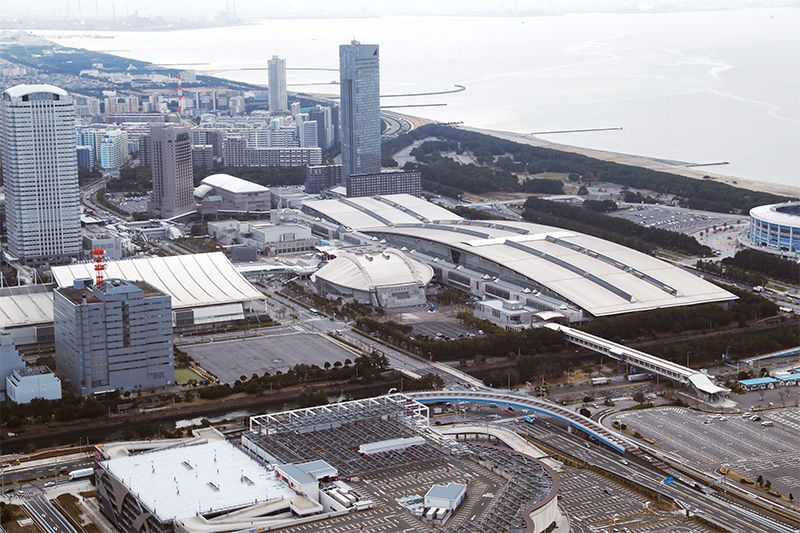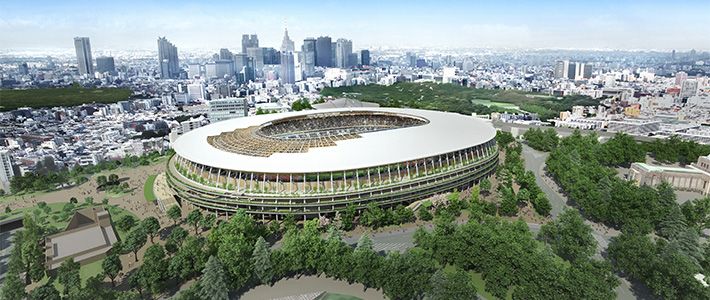
Tokyo 2020 Olympic and Paralympic Venues
Society- English
- 日本語
- 简体字
- 繁體字
- Français
- Español
- العربية
- Русский
| Olympic Games | Paralympic Games | ||
|---|---|---|---|
| Opening and closing ceremonies | 1 | Opening and closing ceremonies | 1 |
| Aquatics (swimming, diving, synchronized swimming, water polo) | 12, 20, 21 | Archery | 19 |
| Archery | 19 | Athletics | 1 |
| Athletics | 1 | Badminton | 3 |
| Badminton | 23 | Boccia | 9 |
| Baseball/softball | 29 | Canoeing | 17 |
| Basketball | 25 | Cycling | 34 |
| Boxing | 7 | Equestrian | 22 |
| Canoeing and kayaking | 17, 18 | Five-a-side soccer | 14 |
| Cycling | 5, 10, 34, 35 | Goalball | 28 |
| Equestrian | 16, 22 | Jūdō | 4 |
| Fencing | 28 | Powerlifting | 6 |
| Golf | 27 | Rowing | 17 |
| Gymnastics | 9 | Shooting | 26 |
| Handball | 3 | Sitting volleyball | 28 |
| Hockey | 15 | Swimming | 20 |
| Jūdō | 4 | Table tennis | 2 |
| Karate | 4 | Taekwondo | 28 |
| Modern pentathlon | 23, 24 | Triathlon | 12 |
| Rowing | 17 | Wheelchair basketball | 8, 23 |
| Rugby sevens | 24 | Wheelchair fencing | 28 |
| Sailing | 33 | Wheelchair rugby | 3 |
| Shooting | 26 | Wheelchair tennis | 11 |
| Skateboarding | 14 | ||
| Soccer | 1, 24, 30, 31, 36, 37 | ||
| Sport climbing | 14 | ||
| Surfing | 32 | ||
| Table tennis | 2 | ||
| Taekwondo | 28 | ||
| Tennis | 11 | ||
| Triathlon | 12 | ||
| Volleyball | 8, 13 | ||
| Weightlifting | 6 | ||
| Wrestling | 28 | ||
Venues in the Tokyo Area
1. Olympic Stadium (National Stadium) (new venue)
Olympics: Opening and closing ceremonies, athletics, soccer
Paralympics: Opening and closing ceremonies, athletics
- Capacity: 80,000 (during the Olympics). Scheduled for completion in November 2019. Designed by Kuma Kengo.
- Access: On foot from Sendagaya Station or Shinanomachi Station on the JR Chūō-Sōbu Line.
- Nearby sightseeing spots: Jingū Gaien, Aoyama, Omotesandō.
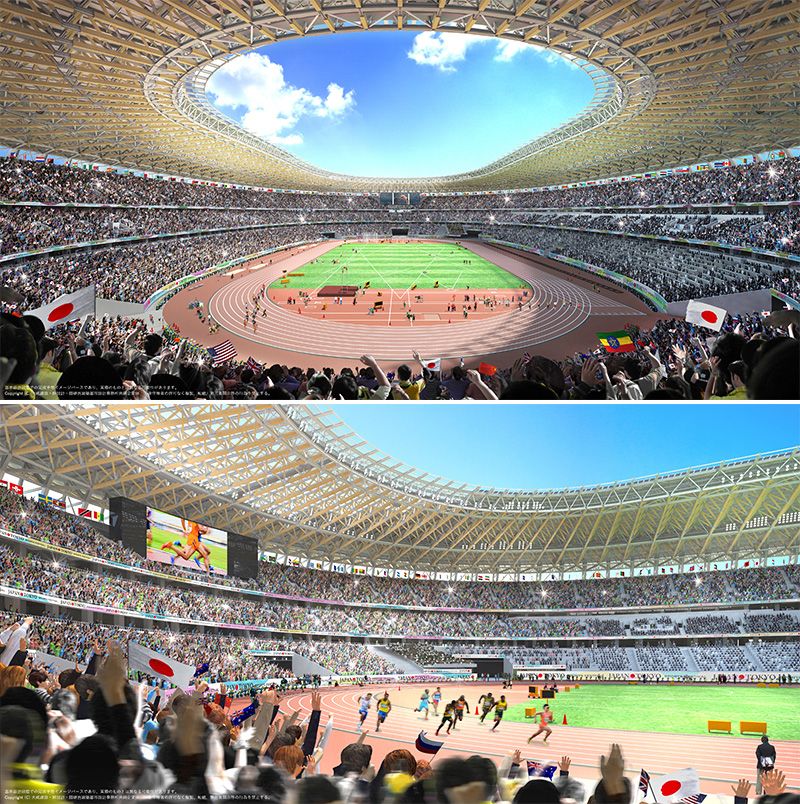 Artist’s impression of inside view of Olympic Stadium (top) and track-and-field events. (Design Works and Construction Works of Taisei Corporation, Azusa Sekkei Co., Ltd., and Kengo Kuma and Associates JV/Courtesy of JSC)
Artist’s impression of inside view of Olympic Stadium (top) and track-and-field events. (Design Works and Construction Works of Taisei Corporation, Azusa Sekkei Co., Ltd., and Kengo Kuma and Associates JV/Courtesy of JSC)
2. Tokyo Metropolitan Gymnasium
Olympics: Table tennis
Paralympics: Table tennis
- Reconstructed in 1990 based on a design by Maki Fumihiko. Renovated in 2012.
- Access: Directly from Sendagaya Station on the JR Chūō-Sōbu Line.
- On the west side of Olympic Stadium.
3. Yoyogi National Stadium
Olympics: Handball
Paralympics: Badminton, wheelchair rugby
- Venue for aquatics events and basketball at the 1964 Olympics. Designed by Tange Kenzō.
- Access: On foot from Harajuku Station on the JR Yamanote Line.
- Nearby sightseeing spots: Meiji Shrine, Yoyogi Park, Harajuku, Shibuya.
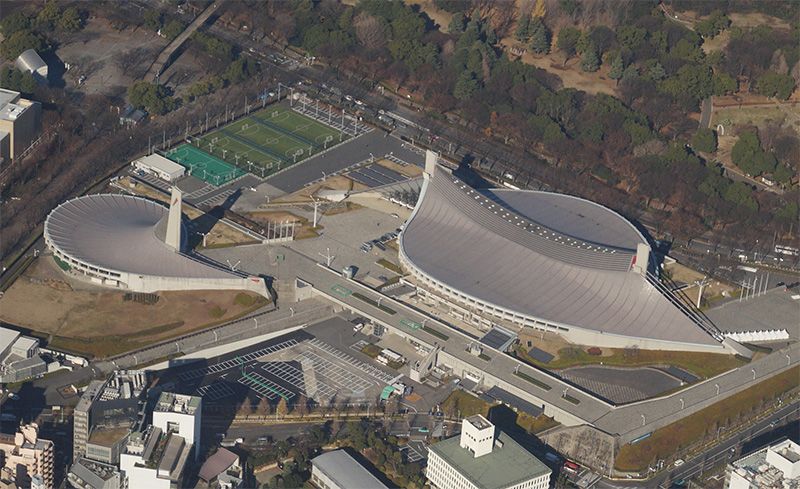 Yoyogi National Stadium (© Tokyo 2020)
Yoyogi National Stadium (© Tokyo 2020)
4. Nippon Budōkan
Olympics: Jūdō, karate
Paralympics: Jūdō
- Jūdō venue at the 1964 Olympics. Also known as a large-scale concert venue. The Beatles performed here in 1966.
- Access: On foot from Kudanshita Station on the Metro Tōzai and Hanzomon Lines and the Tōei Shinjuku Line.
- Nearby sightseeing spots: Imperial Palace, Yasukuni Shrine.
5. Imperial Palace Garden
Olympics: Cycling: (Road start and finish)
Access: On foot from Nijūbashimae on the Metro Chiyoda Line or Hibiya Station on the Metro Hibiya Line.
- Nearby sightseeing spots: Imperial Palace, Tokyo Station.
6. Tokyo International Forum
Olympics: Weightlifting
Paralympics: Powerlifting
- Designed by Rafael Viñoly and opened in 1997 as a general cultural facility.
- Access: Directly from Yūrakuchō Station on the JR Keihin-Tōhoku and Yamanote Lines and the Metro Yūrakuchō Line.
- Nearby sightseeing spots: Imperial Palace, Hibiya Park, Ginza.
7. Ryōgoku Sumō Hall (Kokugikan)
Olympics: Boxing
- Completed in 1984. A major sumō venue.
- Access: On foot from Ryōgoku Station on the JR Chūō Sōbu Line and the Tōei Ōedo Line.
- Nearby sightseeing spots: Asakusa, Sumida River
8. Ariake Arena (new venue)
Olympics: Volleyball
Paralympics: Wheelchair basketball (final)
- Planned as a facility including an arena with a capacity of more than 10,000.
- Access: On foot from Shin-Toyosu Station or Ariake-Tennis-no-Mori Station on the New Transit Yurikamome Line.
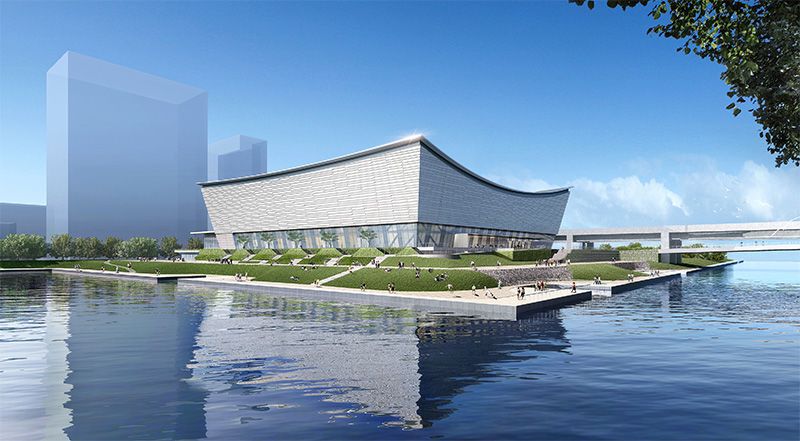 October 2015 artist’s impression of Ariake Arena (© Tokyo Metropolitan Government)
October 2015 artist’s impression of Ariake Arena (© Tokyo Metropolitan Government)
9. Olympic Gymnastic Center (new venue)
Olympics: Gymnastics (artistic, rhythmic, and trampoline)
Paralympics: Boccia
- A new venue with a capacity of 12,000. Tokyo Metropolitan Government will convert it for use as an exhibition hall for 10 years after the Olympics.
- Access: On foot from Kokusai Tenjijō Station on the Rinkai Line.
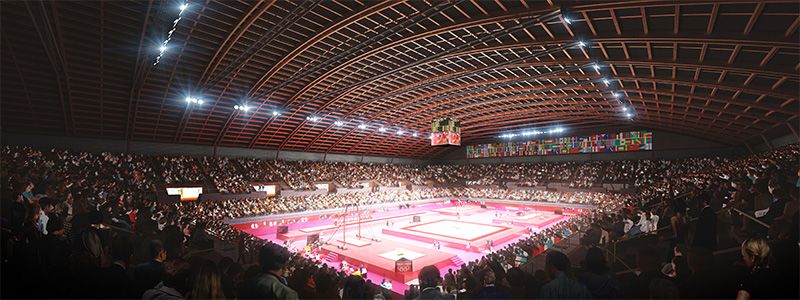 March 2016 artist’s impression of Olympic Gymnastic Center interior (© Tokyo 2020)
March 2016 artist’s impression of Olympic Gymnastic Center interior (© Tokyo 2020)
10. Olympic BMX Course (temporary venue)
Olympics: Cycling (BMX)
- Planned to be built in the north of the Ariake district near the Olympic Village.
- Access: On foot from Kokusai Tenjijō Station on the Rinkai Line.
11. Ariake Tennis Park
Olympics: Tennis
Paralympics: Wheelchair tennis
- The main Ariake Coliseum facility has a capacity of 10,000, an all-weather court, and a retractable roof.
- Access: On foot from Kokusai Tenjijō Station on the Rinkai Line.
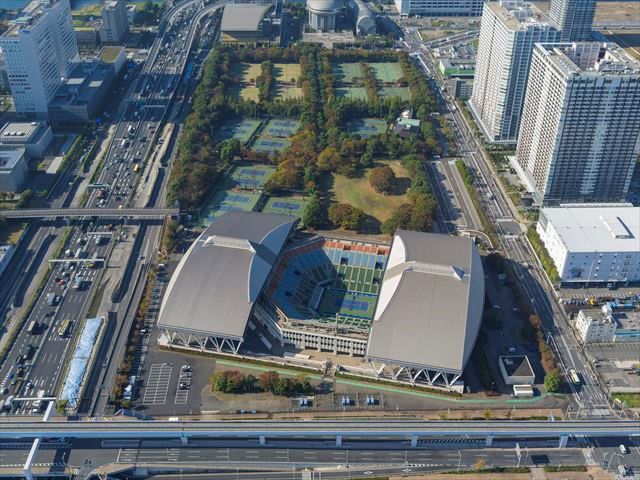 Ariake Tennis Park (© Tokyo 2020)
Ariake Tennis Park (© Tokyo 2020)
12. Odaiba Marine Park
Olympics: Swimming (marathon), triathlon
Paralympics: Triathlon
Access: On foot from Daiba Station or Odaiba-Kaihinkōen Station on the New Transit Yurikamome Line.
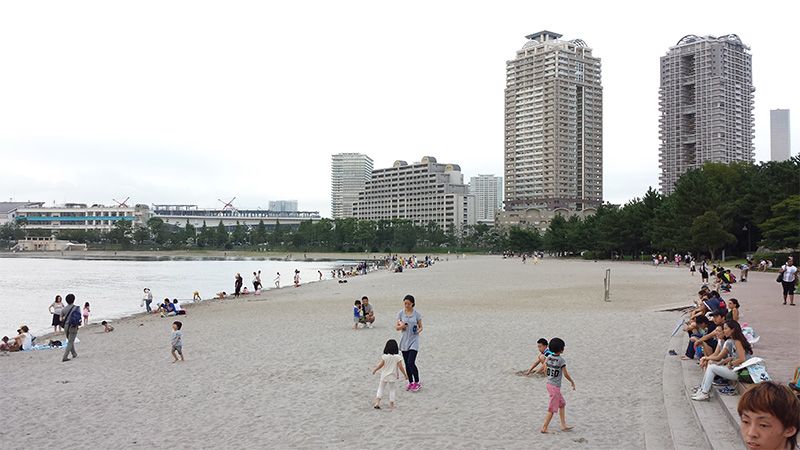 Odaiba Marine Park (© Tokyo 2020)
Odaiba Marine Park (© Tokyo 2020)
13. Shiokaze Park
Olympics: Beach volleyball
- Next to Odaiba Marine Park.
- Access: On foot from Daiba Station on the New Transit Yurikamome Line.
14. Aomi Urban Sports Venue (temporary venue)
Olympics: Skateboarding, sport climbing
Paralympics: Five-a-side soccer
- A temporary venue to be built in the Odaiba district.
15. Marine Park Hockey Stadium (new venue)
Olympics: Hockey
- A new stadium with artificial turf to be built in Ōi Pier Central Marine Park.
- Access: On foot from Ōi Keibajō-mae Station on the Tokyo Monorail.
16. Sea Forest Cross-Country Course (temporary venue)
Olympics: Equestrian (eventing, cross-country)
17. Sea Forest Waterway (new venue)
Olympics: Canoeing/kayaking (sprint), rowing
Paralympics: Canoeing, rowing
- Scheduled for completion in March 2019.
18. Canoe Slalom Course (new venue)
Olympics: Canoeing/kayaking (slalom)
- New venue to be built next to Kasai Rinkai Park.
- Access: On foot from Kasairinkaikōen Station on the JR Keiyō Line.
19. Dream Island Archery Field (new venue)
Olympics: Archery
Paralympics: Archery
- Access: On foot from Shin-Kiba Station on the JR Keiyō Line, the Metro Yūrakuchō Line, and the Rinkai Line.
20. Olympic Aquatics Center (new venue)
Olympics: Aquatics (swimming, diving, synchronized swimming)
Paralympics: Swimming
- New venue to be built in Tatsuminomori Marine Park.
- Access: On foot from Tatsumi Station on the Metro Yūrakuchō Line.
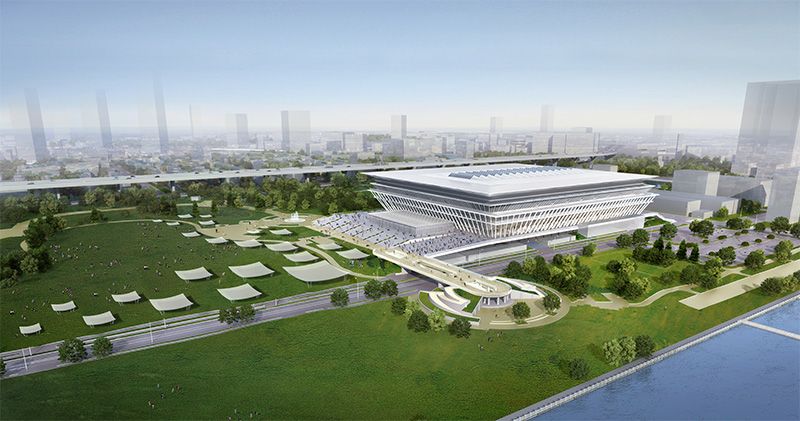 October 2015 artist’s impression of Olympic Aquatics Center (© Tokyo Metropolitan Government)
October 2015 artist’s impression of Olympic Aquatics Center (© Tokyo Metropolitan Government)
21. Tatsumi International Swimming Center
Olympics: Aquatics (water polo)
- Access: On foot from Tatsumi Station on the Metro Yūrakuchō Line.
22. Equestrian Park
Olympics: Equestrian (dressage, eventing, jumping)
Paralympics: Equestrian
- Equestrian venue at the 1964 Olympics.
- Access: On foot from Sakura-Shinmachi Station on the Tōkyū Den-en-toshi Line. By bus from Yōga Station on the same line.
23. Musashino Forest Sport Center (new venue)
Olympics: Badminton, modern pentathlon (fencing)
Paralympics: Wheelchair basketball
- New venue to be built next to Tokyo Stadium.
- Access: On foot from Tobitakyū Station on the Keiō Line.
24. Tokyo Stadium (Ajinomoto Stadium)
Olympics: Soccer, rugby sevens, modern pentathlon (swimming, riding, running, shooting)
- A major stadium with a capacity of 50,000.
- Access: On foot from Tobitakyū Station on the Keiō Line.
25. Saitama Super Arena
Olympics: Basketball
- The country’s largest multipurpose hall with a maximum capacity of 37,000.
- Access: Directly from Saitama-Shintoshin Station on the JR Keihin-Tōhoku, Utsunomiya, and Takasaki Lines.
26. Asaka Shooting Range (temporary venue)
Olympics: Shooting
Paralympics: Shooting
- Access: Around 30 minutes on foot from Wakōshi Station on the Tōbu Tōjō Line and Metro Yūrakuchō and Fukutoshin Lines. By bus from Ōizumi-Gakuen Station on the Seibu Ikebukuro Line.
27. Kasumigaseki Country Club
Olympics: Golf
- Opened in 1929. Hosted the Canada Cup (now the World Cup of Golf) in 1957 and has hosted the Japan Open Golf Championship and Japan Women's Open Golf Championship.
- Access: On foot from Kasahata Station on the JR Kawagoe Line.
28. Makuhari Messe
Olympics: Fencing, taekwondo, wrestling
Paralympics: Goalball, sitting volleyball, taekwondo, wheelchair fencing
- Access: On foot from Kaihin-Makuhari Station on the JR Keiyō Line.
29. Yokohama Stadium
Olympics: Baseball, softball
- Home field of Central League baseball team Yokohama DeNA BayStars with a capacity of 30,000
- Access: On foot from Kannai Station on the JR Keihin-Tōhoku and Negishi Lines and the Yokohama Blue Line.
30. Saitama Stadium
Olympics: Soccer
- Japan’s largest dedicated soccer stadium with a capacity of 63,000.
- Access: On foot from Urawa-Misono Station on the Metro Namboku Line and the Saitama Railway Line.
31. International Stadium Yokohama
Olympics: Soccer
- Japan’s largest stadium with a capacity of 72,000. FIFA World Cup final venue in 2002.
- Access: On foot from Shin-Yokohama Station on the JR Tōkaidō Shinkansen and Yokohama Lines and the Yokohama Blue Line.
Venues Outside the Tokyo Area
32. Tsurigasaki Beach Surfing Venue
Olympics: Surfing
Access: Around 60 minutes on a JR Keiyō or Sotobō Line limited express train from Tokyo Station to Kazusa-Ichinomiya Station. Around 90 minutes by car from central Tokyo.
33. Enoshima Yacht Harbor
Olympics: Sailing
- Access: Around 60 minutes on an Odakyū Line Romancecar limited express train from Shinjuku Station to Katase-Enoshima Station. Around 70 minutes from Tokyo Station to Enoshima Station changing from the Tōkaidō Line to the Enoshima Electric Railway at Fujisawa Station.
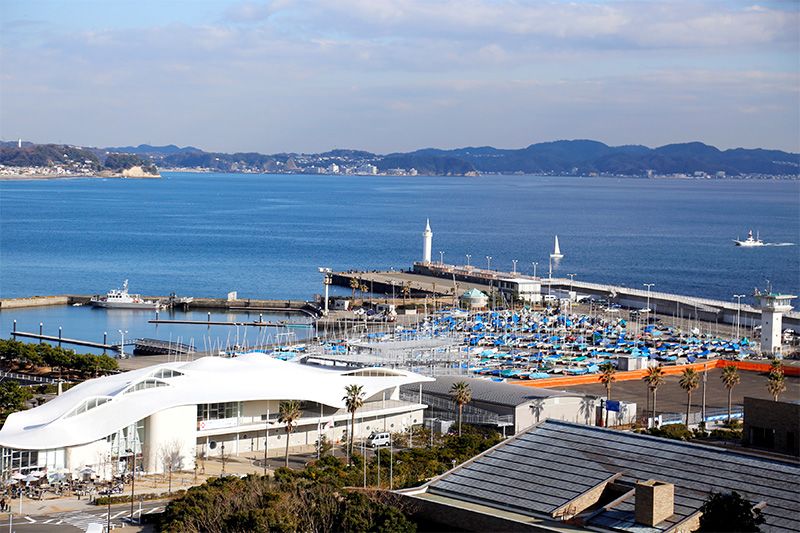 Enoshima Yacht Harbor (© Tokyo 2020)
Enoshima Yacht Harbor (© Tokyo 2020)
34. Izu Velodrome
Olympics: Cycling (track)
Paralympics: Cycling (track)
- Includes 250-meter indoor cycling track with a wooden surface, which meets the standards of Union Cycliste Internationale, the world governing body for cycling.
- Access: By taxi from Usami Station, which is around 90 minutes from Tokyo Station, changing from the Tōkaidō Shinkansen Line to the Itō Line at Atami Station.
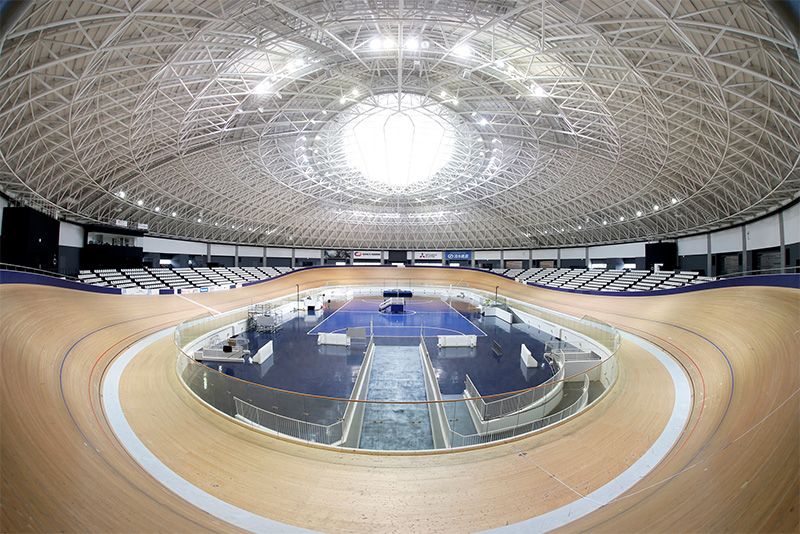 Inside Izu Velodrome (© Tokyo 2020)
Inside Izu Velodrome (© Tokyo 2020)
35. Izu Mountain Bike Course
Olympics: Cycling (mountain bike)
- Access: By taxi from Usami Station, which is around 90 minutes from Tokyo Station, changing from the Tōkaidō Shinkansen Line to the Itō Line at Atami Station.
36. Sapporo Dome
Olympics: Soccer
- Features a sliding grass pitch, which allows the stadium to be used for soccer. It is retracted for baseball games, which use the artificial turf underneath.
- Access: On foot from Fukuzumi Station on the Sapporo Municipal Subway’s Tōhō Line.
37. Miyagi Stadium
Olympics: Soccer- Access: When there are major events, shuttle buses carry passengers from Sendai Station (JR) and Izumi-Chūō Station on the Sendai Subway Nanboku Line.
